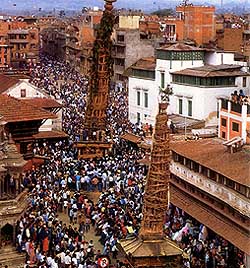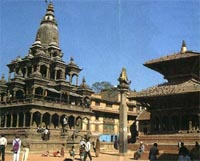Pilgrimage Tour - Lalitpur (Patan)
Of all the Vihars in Kathmandu valley the or Bahas of Patan also known as Lalitpur is more renowned for the artistic workmanship in terracotta, metal and woodworks. Numerically too, the town of Patan has more Bahas than other cities of Kathmandu and Bhaktapur. For Centuries, Patan has remained predominantly Buddhist.
Kwa Baha:
Kwa Baha also well known by its sanskrit name Hiranyavarna Mahavihar, is the foremost Baha (Monastery) of Patan. Situated just down the street from the crossroads known as Kwalakhu Tole, this Baha is probably known as one of the most active lavishly decorated of the Bahas primarily because the community members are wealthy traders who have constantly embellished the complex. The street entrance has two large stone lions as guardians and a stone faced with a stone tympanum depicting celestial Buddhas.

Passing through this entrance and a small entry way leads to the main shrine complex. Nick named as "the Golden temple" inside the complex is numerous gilded images and the facede of imposing Kwapadya shrine (the main deity). The temple in the centre of the courtyard is another attraction which is made of gild copper repousse work. The main shrine is the four storied structure with three gilded roofs. The entrance is flanked by two large cast iron mythical lions each standing on an elephant and surmounted by an image of Lokeswore. The doorway to the shrine is an excellent temple of metal workmanship- all finished in gilt repousse work and above it is one of the finest tympanum (torana) anywhere all made of silver. The Kawapadyo (main deity of the Baha is a large silver image of Aksobhya facing east.
As said earlier , the other striking feature of this complex is the shimmering temple in the centre of the courtyard, which enshrines as Chaitya from Licchavi era. The shrine is an excellent piece of extraordinary metal work and almost entirely covered with gold and metal. It has a single gilt copper roof above which rises a pinnacle with four snakes whose curved tail raise to hold a multi-staged umbrella over the main bell shaped final, Historically, this Baha dates back to not later than eleventh century A.D. or even earlier.
Uku Baha:
Uku Baha is one of the best preserved and oldest of all Bahas of Patan. Located a minutes walk south medieval heritage. Also known by its from Sundhara (the golden spout), this Baha displays a unique collection of sanskrit name ‘Rudravarna Mahavihar' this Vihar is said to have the largest number of branches in the valley. Passing through a gateway in the street one enters the first compound and an entryway from this is led into Uku Baha itself.
The main shrine is of three two roof structure. Steps leading to the shrine are flanked by large stone mythical lions each standing on a crouching elephant an surmounted by an image of Lokeswore. The doorway is marked by a finely worked repousse if arch of leaf and floral motifs. The Kwapa dyo is a large metal image of Aksobhya. Opposite the shrine in the courtyard runs a row of traditional pieces. The first item is a Lichhavi style Chaitya followed by 'Dharmadhatu Mandala' surmounted by a Vajra, a recess for sacred fire, and a metal lamp on a stand and an image of Manjushree.
Mahabuddha Baha:
The famous temple of Mahabuddha is the best known shrines of Patan. Situated in the south of Patan. Situated in the south of Uku Baha and inside a small cramped courtyard, Mahabudha Buddha complex consists of a large terracotta Sikhara style temple in the centre of the courtyard which houses the shrine of Kwapa dyo with a shrine to the mother deity to the side. Completely made of terracotta in this temple every brick has and image of Buddha. So, the complex is called the temple of "Thousand Buddhas" Although, this unique temple is said to have been influenced by the architectural from of Bodhgaya, a close look would reveal the originality of a Nepalese structure is newly built after the great earthquake of 1934 exactly as of original one, the foundation of the structure was laid during sixteenth century A.D.
Chaku Baha: 
Also known as Tanga Baha, this complex is located in Tanga Tole on the east side of the road leading south from the Patan Durbar Square. The complex doesnot offer a typical Baha complex as most of the buildings and structures are of a recent origin except the free standing temple of main deity or the Kwapa dyo. The Kwapa dyo is the red image of Padamapani Lokeswore. This deity is popularity known as Chakuba dyo or Minnath. The temple structure is two storyed of which upper roof is gilded copper and the lower one is tiled roof. In addition the courtyard has several other pieces of antiquity and archaeological importance. It include a bathing platform, several votive chaityas, stone mandalas, interesting stone mythological lions, a large prayer wheel and a rest houses all dating not later than 17th century A.D.
Ta Baha:
This huge courtyard is located just opposite the Chaku Baha across the street. The complex is well known amongst the Buddhist community primarily because the Baha, in addition to a well established old monastery (Vihar) shrine, also houses the temple of 'Bungadyo' Red Machhendranath. And these two shrines are totally independent in functioning.
Along the southern wall of the complex is the house 'kwapadyo' the shrine of the Baha. It is a single standing probably a part of larger complex in the earlier times. Doorway of the shrine is surmounted by a torana itself surmounted by a triple parasol the deity 'Kwappadyo' is an image of Aksobhaya facing north.
Chovar or Cho Bha:
A very popular Buddhist shrine Chobaha is located in the centre of the Chobhar village above the gorge across the Bagmati river. The complex is an entirely closed courtyard at the top of the hill and the shrine of Kwapadyo is a three storyed, multiple roofed temple, of the three roofs upper most is gilded copper the rest are tiled roofs.
The most striking feature of the temple is the great array of pots pans and household utensils nailed to almost all the open space on the surface above the ground floor. It is believed such offerings are done in the temple so as to benefit the deceased relatives in their after next birth.
The Kwapadyo enshrine in the temple is an image of Adinath –Lokeswore and is the main attraction of the complex.
Ha Baha:
Also known as Hakha Baha or Hatko Baha, is one of the few Bahas of Kathmandu, which has retained the original Baha architectural norms and preserved the medieval beauty. The street entrance is a stone arch torana depicted with fine celestial Buddhas and the door is marked two stone lions. The shrine of the Kwapa dyo opposite the entrance is and imposing three storey temple. The doorway to the shrine is elaborately carved and finished in repousse metal . the image of the Kawapadyo is an image of Aksobhya facing north. In the courtyard, there is on array of several mandalas and Chaitya. Some even dating back 7th century AD from Licchavi period.
Panchdaan:
The alms giving of five offerings. The day differs in each of three cities of the valley. Bahidyo Boyegu - The display of gods and goddess of the shrine which lasts for the days.
Mataya - a festival of light:
This is a typical Patan Buddhists Festival which is not observed elsewhere. On this day, the Buddhists of Patan visit all the Bahas and Buddhist shrines carrying lighted candles, torches or tapers.
SUI-REN Travel Pvt. Ltd. of Nepal
"The Very Best in Travel Services"



